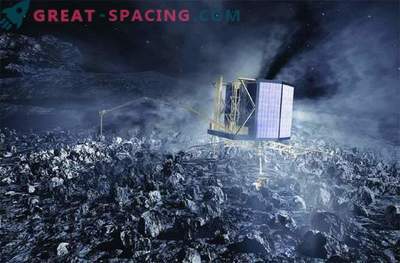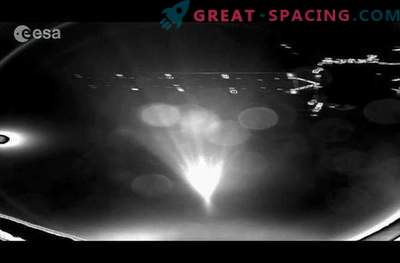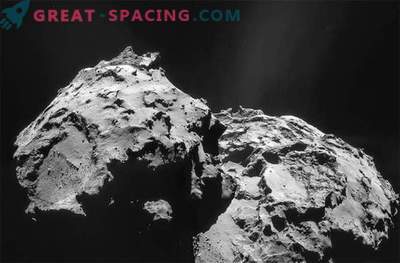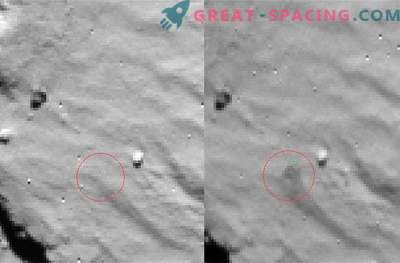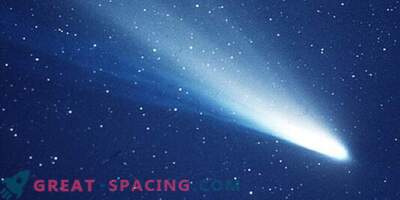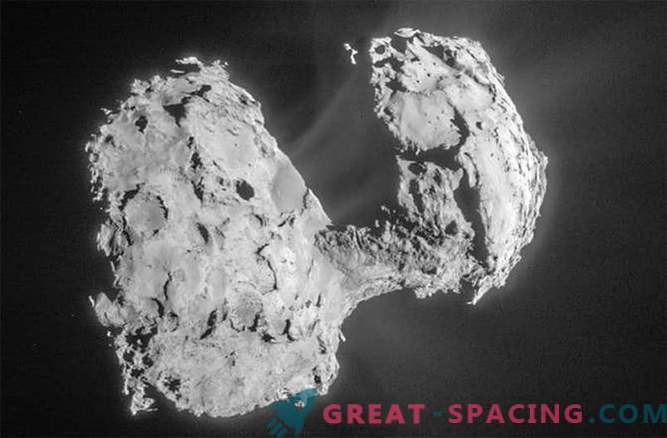
This photograph of comet 67P Churyumov / Gerasimenko was taken on March 14, 2015 with a navigation camera Rosetta, passing at a distance of 85, 7 km from the center of the celestial body. Image resolution is 7, 3 m / pixel, and its size is 6, 4x6, 3 km. At the moment, scientists are cutting and processing a photograph in order to see the smallest details of the comet on it.
The comet, which is currently being studied through the Rosette camera installed on board the Europa spacecraft, may consist entirely of pebbles, which challenges the actual theory of the formation of bodies in the deep regions of the solar system.
Traveling on a comet causes the most dizzying emotions! Therefore, the flight of Rosetta to the rock flying at breakneck speed was an incredible adventure, which was made possible only by high-tech tracing.
Comet 67P Churyumov / Gerasimenko emerged from the Kuiper Belt - the area beyond the orbit of Pluto, which is filled with icy space bodies remaining after the formation of the Solar System about 4, 6 billion years ago.
For the first time, Rosetta approached the comet in August 2014 and three months later released the Phil landing module for additional research. Fila sank to the surface of the planet, but then bounced off to the side several times, and only then was able to gain a foothold on the space object.
Before the descent vehicle lost control, he still managed to conduct a series of previously planned experiments. And today, scientists hope to restore contact with the probe so that it can resume its research on the surface of the planet. During his short mission, Phil was able to collect some critical indicators. Among them are photographs confirming the hypothesis that a comet can consist entirely of pebbles. This was told by scientists participating in the conference in Houston, dedicated to the activities of the moon and planets.
If this information is confirmed, scientists will have to reconsider their view on the possibility of forming such a large pebble object in a region so remote from the Sun.
“Pebble accretion is a new idea,” said astronomer Donald Brownley of Discovery News at Washington University. “The theory is that moving gas can pick up and transport small pebbles, which in turn attract more gas. This can be compared with a magnet. "It is noteworthy that accretion occurs almost instantly. Objects come together almost instantly.
“Rosetta is the first tool to provide documentary evidence of a newly developed theory,” added Brownlee, whose work is in no way connected with this mission. Previously, scientists have already received some signals that comets may be a pile of pebbles. NASA’s “Stardust” spacecraft in 2004 flew past a comet called “Wild-2” and then came back, delivering soil samples to Earth.
With the help of “Stardust” we saw some elements that were much stronger than the surrounding matter, ”added Brownlee, who heads the mission. "We thought that the surrounding matter is just ablations that retain their original blocks. Rosetta discovered a great number of them. Most likely, this is just the garbage from the Kuiper belt, which formed the comet. This means that these materials were not destroyed or compressed at speeds of several kilometers per second. "
Rosette and Phil mission scientists received information on several hundred such objects.
“While we cannot say with due probability that 100% of the comet is formed from pebbles,” said astronomer Holger Sirks of the Max Planck Institute (Germany) - “And the size of this pebble is still impossible to compare with modern models, in which stand out some objects of the solar system. In the outer regions of the solar system, they should be much smaller. ”
Comet 67P is at a distance from the Sun, two times larger than the Earth, and moves towards the center of the solar system. And it is accompanied by its space orbiter Rosette. Scientists plan to study the comet as it approaches the Sun and is heated. Of particular interest is the behavior of jet matter in space. "There are many discoveries ahead of us," said Sirks.

